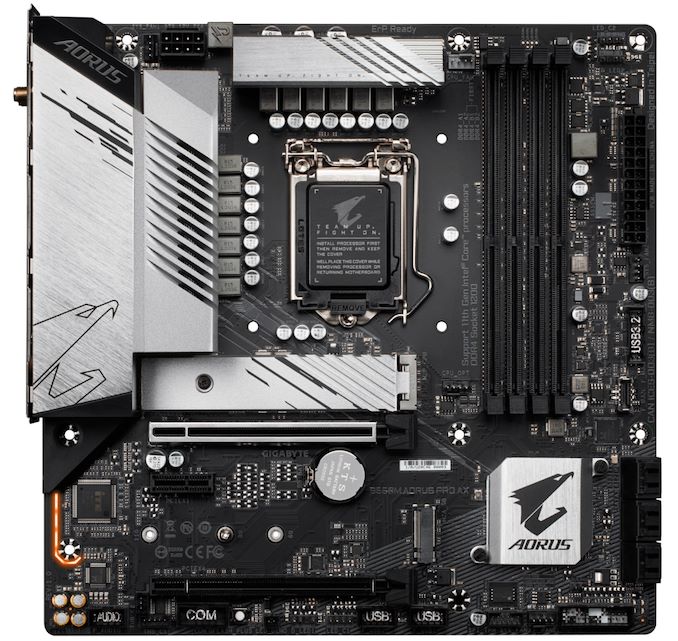The Intel B560 Motherboard Overview: 30+ Budget Models Starting from $75
by Gavin Bonshor on March 29, 2021 7:00 AM ESTGIGABYTE B560M Aorus Pro AX & B560M Aorus Pro
The GIGABYTE B560M Aorus Pro AX is a smaller (micro-ATX) variant of the B560 Aorus Pro AX and includes much of the same feature set, well as much as the reduction in PCB allows. GIGABYTE is also offering a non-AX version, which is identical in features barring the Wi-Fi 6 CNVi. Both the B560M Aorus Pro AX and B560M Aorus Pro follow a slightly different aesthetic to the ATX version, with a black and grey printed PCB and silver heatsinks, with black highlights. GIGABYTE also includes an Aorus Falcon logo on the rear panel cover, with a more prominent logo located on the chipset heatsink.
Located towards the center of the board is a pair of full-length PCIe slots, including one PCIe 4.0 x16 (top), and one PCIe 3.0 x4 (bottom) slot, a smaller PCIe 3.0 x1 located in between these. Storage options include two M.2 slots, including one PCIe 4.0 x4 slot which includes an M.2 heatsink, with a bare slot operating at PCIe 3.0 x4 and includes support for SATA drives too. Looking at SATA, GIGABYTE includes six SATA ports located in the bottom right-hand corner, with support for RAID 0, 1, 5, and 10 arrays. At the present time, GIGABYTE hasn't unveiled its memory QVL, so support is listed as DDR4-3200, with a combined capacity of up to 128 GB across four slots. GIGABYTE is also advertising a direct 12+1 power delivery.
On the rear panel,the B560M Aorus Pro AX includes an Intel AX200 Wi-Fi 6 CNVi which also adds BT 5.1 connectivity, which is the only difference between this model and the regular B560M Aorus Pro. Everything else is the same, including one USB 3.2 G2x2 Type-C, one USB 3.2 G2 Type-A, two USB 3.2 G1 Type-A, and six USB 2.0 ports. Wired networking is taken care of by an Intel I225-V 2.5 GbE controller, while six 3.5 mm audio jacks are powered by an unspecified RealtekHD audio codec. For integrated graphics users, there's one HDMI and one DisplayPort video output, with a PS/2 keyboard and mouse combination port designed for legacy peripherals.












59 Comments
View All Comments
limitedaccess - Tuesday, March 30, 2021 - link
Rocket Lake CPUs have 20 PCIe (4.0) lanes off the CPU. This a departure from previous generations in terms of lane count. Comet Lake (and older) for Intel have 16 lanes off the CPU.4 of those lanes are connected to the "first" m.2 slot of B560/Z590 motherboards. 10th gen CPUs don't have those lanes even as PCIe 3.0. Previous generation motherboards have all their m.2 slots using lanes connected to the chipset.
jrbales@outlook.com - Wednesday, March 31, 2021 - link
Thanks for the explanation. My AMD X570 has PCIE 4 lanes from both CPU and chipset, so this is my first build wheres I'm running up against this limitation. Now it all makes sense and fortunately, I did place my Samsung 970 EVO into the 2nd M.2 slot. Thanks again! And old dog CAN learn something new!ScottSoapbox - Tuesday, March 30, 2021 - link
There are three typos in the first paragraph that Word or a browser would catch if you took 10 seconds to check. Hint: words need spaces between them.Linustechtips12#6900xt - Thursday, April 8, 2021 - link
am I the only one who noticed the CMOS battery on the wifi thing in the asrock board?? lolutmode - Saturday, April 10, 2021 - link
has reaktek fixed speed dropping issue in their RTL8125B 2.5G NICmammuthus - Sunday, June 20, 2021 - link
Guys, witch one I should choose between ASUS ROG Strix B560-I Gaming WIFI and MSI MPG B560I Gaming Edge Wi-Fi?aigo - Thursday, July 29, 2021 - link
There is no sound through HDMI ports regardless of the OS; Linux, Windows. Definitely not a multimedia board, and neither it is for gaming.dwoodcock - Friday, August 13, 2021 - link
After messing about with this board all day trying to get RAID working I find out it doesn't support RAID at all!!!BadConfiguration - Thursday, October 28, 2021 - link
Hi Gavin, will the M.2_2 (marked ultra m2) use the pcie lanes from chipset ? Or would it use the pcie lanes from cpu ?